Thai Eggplant Stir-fry
This post contains affiliate links.
This Thai Eggplant Stir-fry is quick and easy to make and jam-packed with flavor. Juicy eggplant strips and ground pork get tossed with aromatics and Thai sweet basil in a mouthwatering sauce featuring Thai chili paste (Nam Prik Pao)! It’s customizable with your favorite protein, and vegetarian/vegan and gluten-free adaptable.
Calling all my eggplant lovers! 🍆❤️ 😋
I have a new easy weeknight stir-fry for you all today, and it is ridiculously tasty and super easy to make!
We have juicy eggplant strips, onion, garlic, chilies, ground pork, and fragrant Thai sweet basil leaves coming together in this flavor-packed stir-fry with an UBER tasty spicy, salty, and sweet sauce that stars Thai chili paste (aka Nam Prik Pao)! 😍
This Thai Eggplant Stir-fry is perfect for making on any day of the week since it doesn’t require a long prep or cook time. It’s also very easy to cook, and tastes fantastic with a bowl of steamed rice. Once you sink your teeth into the tender and succulent eggplant strips coated in the delicious sauce, you’ll want to make this easy stir-fry over and over again and add it to your repertoire!
Why This Recipe Works
- It’s quick and easy to make on any given weeknight and in one wok/pan.
- Dry-frying the eggplant first in a small amount of oil instead of shallow or deep-frying enables the eggplant to get tender without becoming mushy in the stir-fry. It also enables us to use less oil overall for this dish than a typical Chinese or other Asian eggplant stir-fry.
- Thai chili paste (Nam Prik Pao), along with other umami loaded Asian sauces come together to create a mouthwatering spicy and savory-sweet sauce.
- Thai sweet basil infuses the stir-fry with a fragrant and sweet aroma.
- It’s customizable with your favorite protein, and also vegetarian/vegan and gluten-free adaptable.
Ingredients
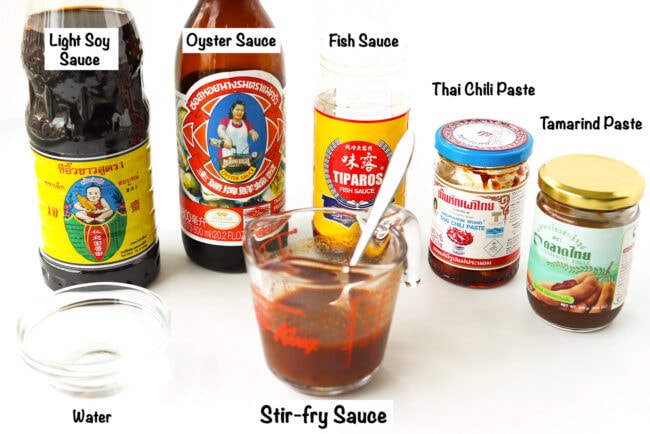
- Thai Chili Paste/Chili Jam (Nam Prik Pao): This is a savory-sweet chili paste that has the texture of jam. You can find it in small glass jars labeled as “Thai chili paste”, “roasted chili paste”, and “roasted chili paste in soybean oil”. It tastes fantastic in stir-fries, soups, and even on a slice of toast or in sandwiches. It’s available in Thai and some Asian grocery stores, as well as online. I use Mae Pranom brand Thai chili paste, which is less sweet than the Pantainorasingh (Pantai) brand Thai chili paste.
- Tamarind Paste/Concentrate: This sour and slightly sweet paste comes in small jars. You can find it in the Asian aisle of some large supermarkets, in Asian and Thai grocery stores, or purchase it online. I use Talad Thai brand. Some brands are more sour than others, so you may need to use more or less of the paste than what I’ve indicated. Be sure to use a Thai tamarind paste and not an Indian one. The latter is black and sticky, and not ideal for this recipe.
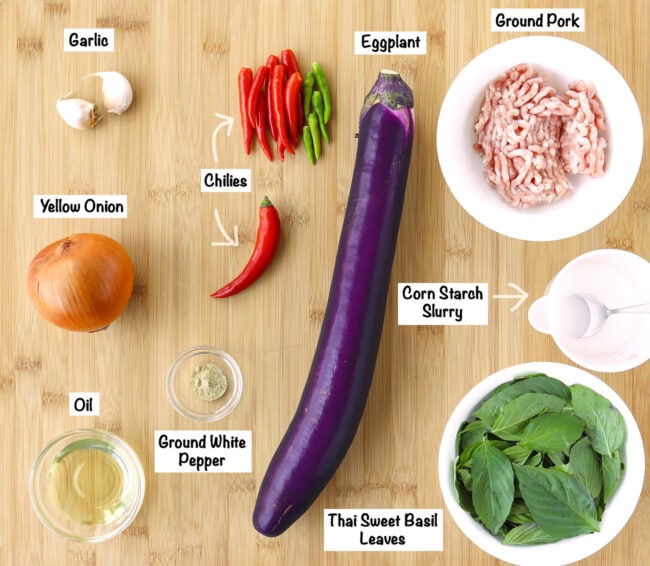
- Ground Pork: If you’re not into pork, feel free to use ground chicken, beef, or turkey instead.
- Eggplant: You can use either a Chinese or Japanese eggplant for this recipe. Chinese eggplants are purple, and long and slim as opposed to oblong shaped. They’re not bitter like the typical eggplants you can find in supermarkets in the U.S, but instead have a sweet and mild flavor. They also have less seeds. They should be available in shops in your local Chinatown (if there is one) and in Asian supermarkets. In Asia, you can find them in supermarkets and wet markets.
- Chilies: I used a combination of red Bird’s Eye chilies, tiny but fiery hot Thai Prik Kee Nu green chilies, and a mild large red chili for color. Feel free to use less or more Bird’s Eye and Prik Kee Nu chilies based on your heat level preference. The large red chili is mainly used for color and isn’t very spicy at all. You can substitute with sliced red bell pepper instead if you don’t have it on hand, or leave it out if you wish.
- Thai Sweet Basil Leaves: Known as ‘horapa’ in Thai, these sweet-smelling basil leaves add plenty flavor and a fragrant aroma to Thai curries and stir-fries. They have purple flowers, and are glossier and smooth in appearance. Look for them at a specialty Thai ingredients store. However, you can also use Thai holy basil leaves (known as gaprao, kra pow, kaprao in Thai), which have a different and peppery flavor profile. If you can’t find either, substitute with regular Italian basil – the dish will still taste great!
- Oil: I used canola oil, but any other neutral-flavored cooking oil with a high smoke point will work.
- Corn starch slurry: This will be used to thicken the sauce. I prefer the sauce to be on the thinner side so only used a teaspoon of corn starch for the slurry. But feel free to use more or less corn starch based on how thick you’d like the sauce to be.
Full ingredient list and amounts are in the recipe card below.
How to Make Thai Eggplant Stir-fry
Prepare the ingredients:
- Whisk: Whisk together all the sauce ingredients in a measuring cup or bowl. Whisk together the corn starch and water to make a slurry.
- Chop: Chop all the aromatics and veggies, and pluck the Thai sweet basil leaves off the stems. Give them a good rinse, then pat-dry with some paper towels. Smash the garlic and chilies in a mortar and pestle into a coarse paste. (Or smash with the back of your knife and finely chop if you don’t own a mortar and pestle).
- Soak: Soak the eggplant strips in a bowl filled with water for a couple of minutes.
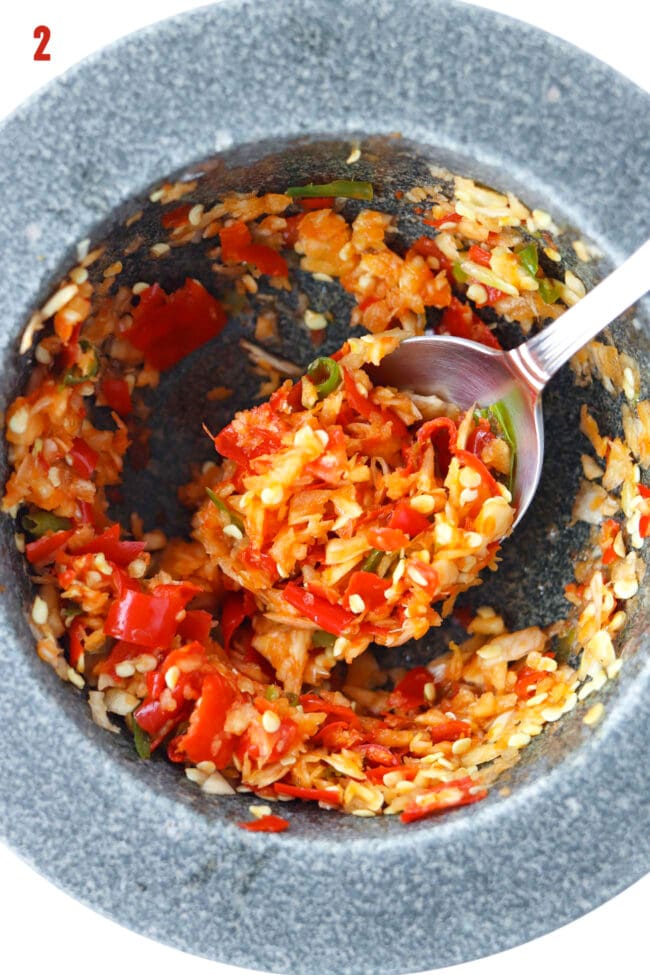
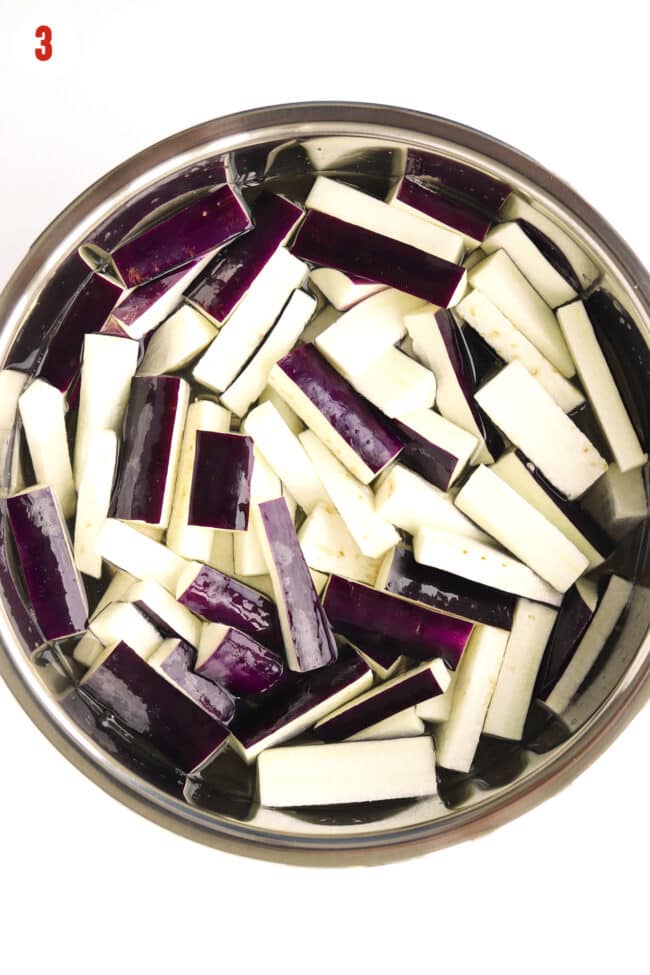
Soaking the eggplant strips in water will make them less prone to soaking up the oil like sponges. It allows us to get away with dry-frying them in less oil instead of deep-frying before using them for the stir-fry.
For the Thai Eggplant Stir-fry:
- Cook the eggplant: In a bit of oil in a large wok for a few minutes. Toss occasionally until slightly browned and tender. Transfer to a clean bowl. (The residual heat will allow the eggplant to continue cooking and become tender.)
- Stir-fry the aromatics: Add a bit more oil to the wok and stir-fry the onion, smashed garlic chili paste, and large red chili for a minute or until fragrant.
- Add the pork: Season the pork with ground white pepper and cook for a few minutes, until the pork is just cooked through.
- Add the eggplant and sauce: Toss to combine and coat everything in the sauce.
- Pour in the corn starch slurry: Toss for a minute until the sauce has slightly thickened.
- Stir through basil: Allow it to wilt slightly for a few seconds, then switch off the heat.
- Serve! Transfer to a serving dish and serve immediately with warm steamed rice!
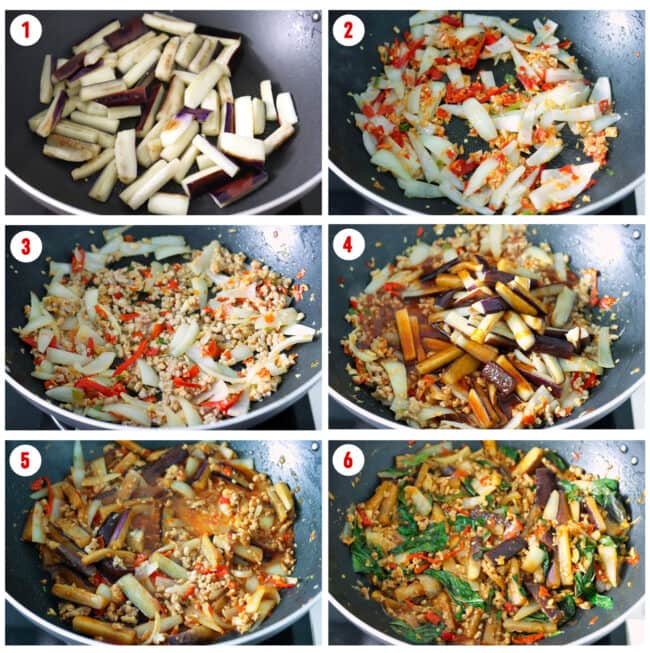
Full detailed instructions are in the recipe card below.
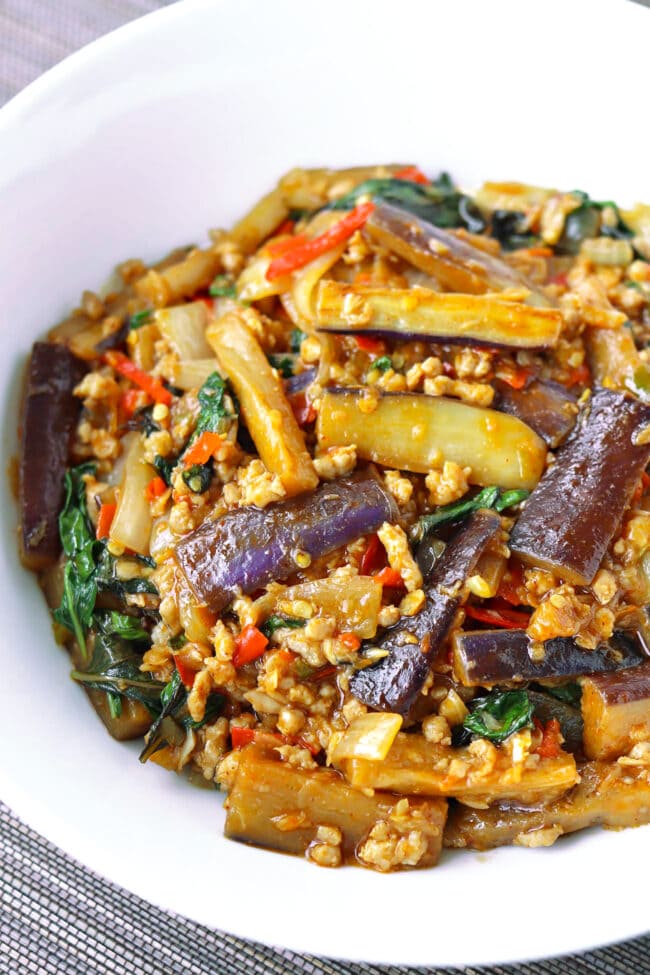
Cook’s Tips
- Avoid adding too much oil from the Thai chili paste jar to the sauce. Use mostly the paste and less oil when spooning it out from the jar.
- Prepare all the ingredients before you start cooking. This is a quick stir-fry, so it’s best to prepare all your ingredients before you switch on the stove.
- Wear onion goggles or sunglasses when pounding the garlic and chilies in the mortar and pestle. Sometimes when smashing the aromatics in the mortar, small bits can jump out. Protect your eyes first, and then start pounding!
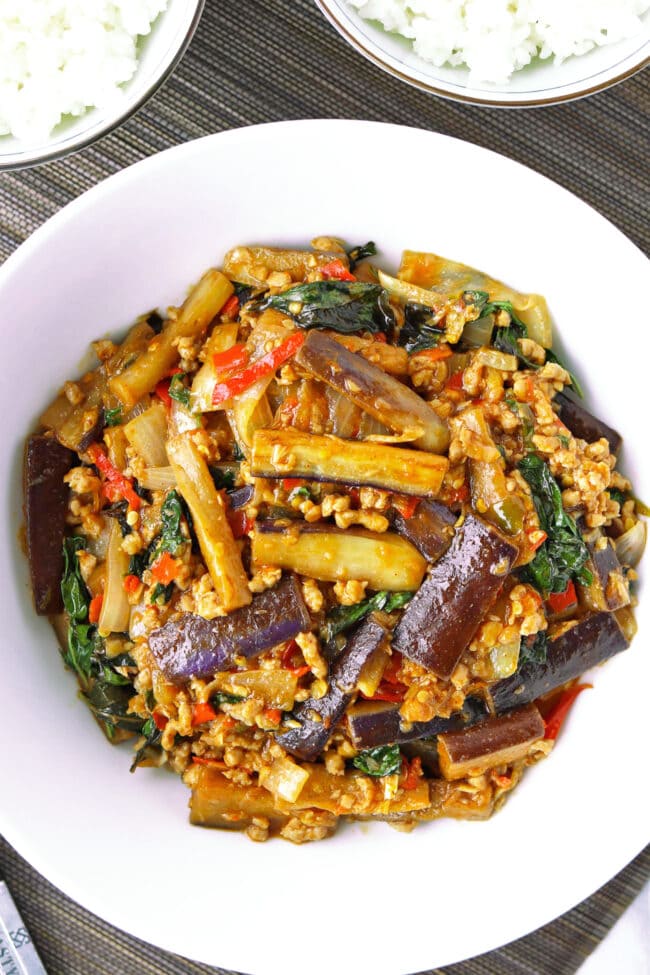
Variations
- Use other meat. Feel free to use ground chicken, beef, turkey, etc. in place of the pork.
- Make it vegetarian/vegan. Use crumbled firm tofu or a plant-based meat substitute such as OmniPork, Beyond Beef®, Quorn™ Mince, or Impossible™ Burger in place of the pork. Alternatively, simply use more eggplant and omit the pork. Also, use a vegetarian oyster sauce, additional soy sauce to replace the fish sauce. You can find several vegetarian/vegan recipes for Thai chili paste/Nam Prik Pao online, and make one to use in this Thai eggplant stir-fry. There’s also a vegetarian Thai chili paste produced by Mae Pranom. But at the time of writing, it is currently unavailable on Amazon. It may be more difficult to track it down than to make your own.
- Make it gluten-free. Use a gluten-free soy sauce and oyster sauce, and double check that your fish sauce and Thai chili paste is GF certified. (They both usually are, but it’s best to make sure.)
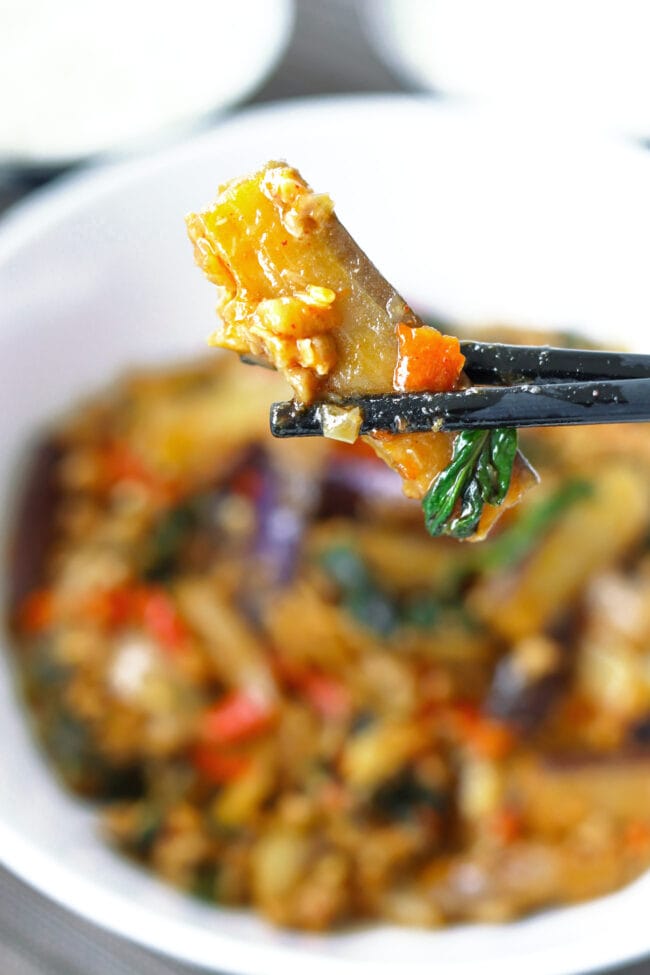
FAQs
Thai chili paste is made with soybean oil, dried shrimp, onion, garlic, dried chilies, tamarind, sugar, salt, and shrimp paste. Everything is first blended together, and then roasted in a pan before being packaged in small jars.
There isn’t one, unfortunately. You can make your own Thai chili paste if you can’t get a hold of the store-bought type.
Besides stir-fries, Thai chili paste can also be used in soups and sandwiches.
Once opened, store the jar of Thai chili paste in the refrigerator. The oil in the paste acts as a preservative, and will keep the paste fresh so that it lasts for a couple of months in the fridge.
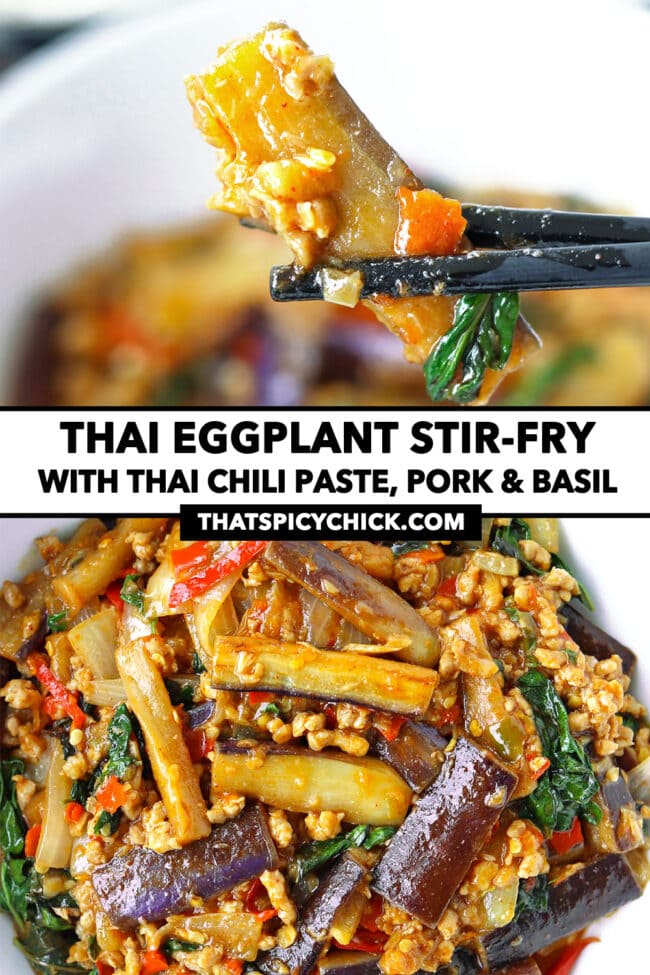
More Thai Stir-fries
- Khua Kling Moo (Southern Thai Dry Curry Pork)
- Thai Cashew Chicken
- Thai Holy Basil Chicken (Pad Kra Pow Gai)
- Peanut Sauce Ground Pork Stir-fry
- Spicy Thai Basil Chicken (with Thai sweet basil)
- Or browse the entire Thai and Stir-fry recipe collections.
MADE THIS RECIPE? If you make this recipe, leave a comment below and let me know how you liked it! Take a photo and tag it with @thatspicychick on Instagram and hashtag it #thatspicychick and I’ll be sure to share your masterpiece!
STAY CONNECTED! You can also follow me on Pinterest, Facebook or Instagram. Sign up for my email list to get my latest recipe in your inbox weekly!
PrintThai Eggplant Stir-fry (with Chili Paste, Pork & Basil)
Juicy eggplant strips and ground pork get tossed with aromatics and fragrant Thai sweet basil in a mouthwatering sauce featuring Thai chili paste (Nam Prik Pao) in this quick and easy weeknight stir-fry!
- Prep Time: 15
- Cook Time: 16
- Total Time: 31 minutes
- Yield: 3 1x
- Category: Dinner
- Method: Stir-fry
- Cuisine: Thai
Ingredients
For the Sauce:
- 1.5 TBLS Thai Chili Paste/Chili Jam (Nam Prik Pao)
- 1 TBLS Oyster Sauce
- 1 TBLS Light Soy Sauce
- 1 TBLS Fish Sauce
- ½ TBLS Tamarind Paste
- ½ – 1 TSP White Sugar (optional), to taste (see notes)
- 2 TBLS Water
For the Thai Eggplant Stir-fry:
- 300–320 grams / 10.5-11.3 ounces (1 large) Chinese or Japanese Eggplant – cut into 1.5-inch long strips
- 6 Garlic cloves – roughly chopped
- 2–8 Red Chilies (Bird’s Eye preferred, but any small hot red chilies will work), to taste – roughly chopped
- 3–5 Prik Kee Nu Green Chilies (optional), to taste – roughly chopped
- 1 Large Red Chili – thinly sliced at an angle
- 1/3 medium Yellow Onion – cut into ¼-inch strips, then cut in half
- 3.5 TBLS Canola Oil (or any other neutral-flavored cooking oil with a high smoke point)
- 150 grams Ground Pork / 5.3 ounces (or ground chicken, beef, or turkey)
- ¼ TSP Ground White Pepper
- 1.5 cups Thai Sweet Basil Leaves – picked off stems, washed and pat-dried (substitute with Thai holy basil or Italian basil if unavailable)
- 1 TSP Corn Starch + 1/3 cup Water (mixed together to make a slurry)
- To Serve (optional): Steamed rice
Instructions
Prep:
- Prepare the fresh ingredients: Chop/prepare the eggplant, garlic, red chilies, Prik Kee Nu green chilies (if using), large red chili, yellow onion, and Thai sweet basil leaves as indicated in the ‘Ingredients’ section. Transfer the eggplant to a bowl filled with water and soak for 15-20 minutes. Using a mortar and pestle, pound the garlic, Bird’s Eye red chilies, Prik Kee Nu green chilies into a coarse paste and set aside. (Or smash with the back of your knife and finely chop if you don’t own a mortar and pestle.)
- Make the sauce: Whisk together the Thai chili paste, oyster sauce, light soy sauce, tamarind paste, and water in a measuring cup (for easier pouring) or small bowl and set aside.
- Make the corn starch slurry: Mix the corn starch and water in a measuring cup or bowl and set aside.
For the Thai Eggplant Stir-fry:
- Cook the eggplant: Heat 2 tablespoons of canola oil in a large wok over medium-high heat. Once hot, add the eggplant and cook for 8-10 minutes, tossing occasionally, until slightly browned and tender. Transfer to a clean bowl and return the wok to the stovetop. (Don’t worry if the eggplant isn’t completely tender yet. The residual heat will allow it to continue cooking and become tender in the bowl.)
- Stir-fry the aromatics: Heat the remaining 1.5 tablespoons of oil over medium-high heat in the wok. Once hot, add the onion and stir-fry for 30 seconds until slightly softened. Then add the smashed garlic chili paste and large red chili and toss to combine for 30 seconds until fragrant.
- Cook the pork: Add the ground pork and ground white pepper. Cook for 2 minutes, breaking up the lumps with your spatula, until just cooked.
- Add the eggplant and sauce: Add the eggplant back into the wok and pour in the sauce. Toss briefly until everything is combined well and coated in the sauce.
- Add the corn starch slurry: Give the corn starch slurry a quick stir with a spoon (the corn starch will have settled at the bottom of the measuring cup/bowl), then pour it into the wok. Toss for a minute until the sauce has thickened.
- Stir through basil: Add the Thai sweet basil leaves and briefly toss until slightly wilted – about 15-20 seconds, then switch off the heat.
- To Serve: Transfer to a serving dish and serve immediately with warm steamed rice.
Notes
Ingredient Notes, Cook’s Tips, and FAQs
- Thai Chili Paste/Chili Jam (Nam Prik Pao): This is a savory-sweet chili paste that has the texture of jam. It is available in small glass jars and goes by “Thai chili paste”, “roasted chili paste”, and “roasted chili paste in soybean oil”. Look for it in Thai or Asian grocery stores, or purchase it online. I use Mae Pranom brand, which is less sweet than the Pantainorasingh (Pantai) brand Thai chili paste. When making the sauce, avoid adding too much oil from the jar and use mostly the paste. You can use this condiment in other stir-fries, soups, and in sandwiches too. It will last for a few months in the fridge once opened.
- Tamarind Paste/Concentrate: This sour and slightly sweet paste comes in small jars, and can be found in the Asian aisle of some large supermarkets, Asian and Thai grocery stores, or purchased online. I use Talad Thai brand. Some brands are more sour than others, so you may need to use more or less of the paste than what I’ve indicated. Make sure to use a Thai tamarind paste and not an Indian one. The latter is black and sticky, and not ideal for this recipe.
- Chilies: Use less or more Bird’s Eye and Prik Kee Nu chilies based on your heat level preference. The large red chili is mainly used for color and is very mild. Substitute it with sliced red bell pepper, or leave it out if you wish.
- White Sugar: Depending on how sweet your Thai chili paste is, you may not need to add any sugar (I didn’t as I find that the Thai chili paste from Mae Pranom brand is plenty sweet enough for me). You may want to taste your Thai chili paste on its own to gauge how sweet it is and decide if you need to add any sugar to the stir-fry sauce.
- See ‘Variations’ section in the post above if you’d like to customize this stir-fry.
Nutrition
- Serving Size: 1 serving
- Calories: 423
- Sugar: 15.9g
- Sodium: 976mg
- Fat: 29.1g
- Saturated Fat: 5.2g
- Unsaturated Fat: 21.1g
- Trans Fat: 0.1g
- Carbohydrates: 29.8g
- Fiber: 5.9g
- Protein: 14g
- Cholesterol: 36mg
This post may contain affiliate links. We are a part of the Amazon Services LLC Associates Program, an affiliate advertising program designed to provide a means for us to earn a small commission (at no extra cost to you) by linking to Amazon.com and affiliated sites. The nutritional information provided is approximate and can vary based on several factors. It should only be used as a general guideline. For more information, please see our Disclosure.

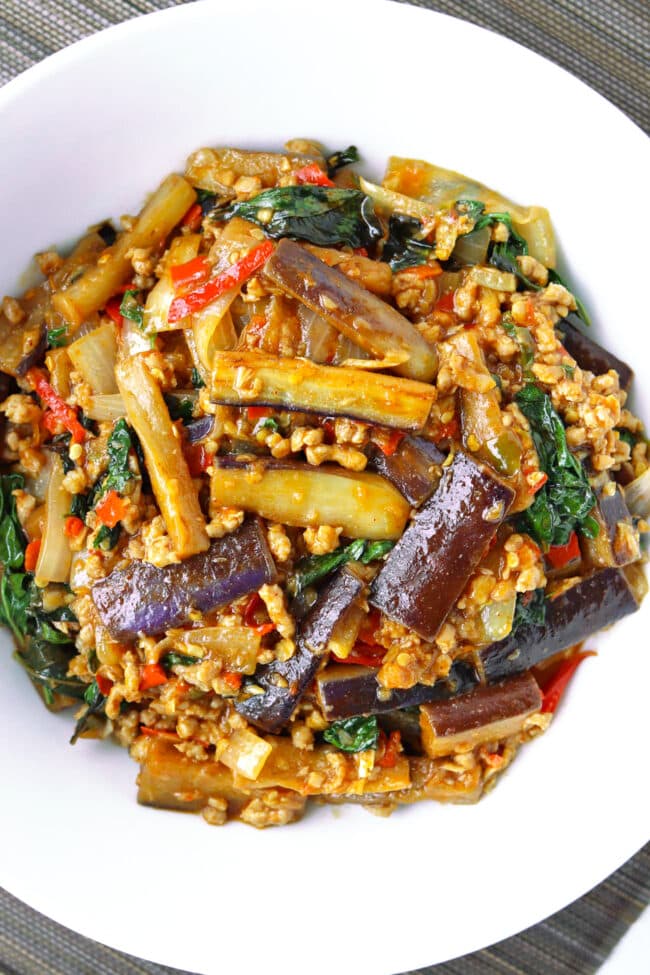
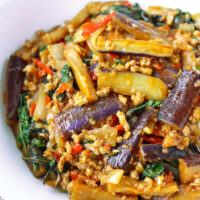







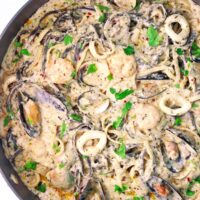
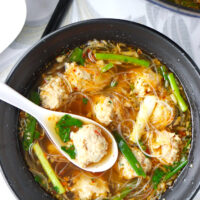














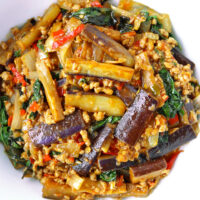


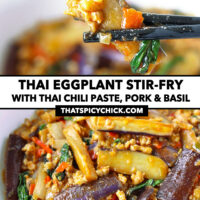
This was AMAZING! I made it as is for my kids and they licked the dish clean. I also followed your tips for making it vegetarian. The Asian supermarket had the Mae Pranom Thai chili jam and I used veggie oyster sauce and Impossible Pork. It came out so yummy too! Will be making both versions again. Thanks for the great recipe.
Thanks so much Elizabeth! I’m glad your kids enjoyed the recipe, and happy that the Impossible pork version was delicious too!
Eggplants are my favourite. I will definitely try this dish.
Eggplants are the BEST! Hope you enjoy, Rita. 🙂